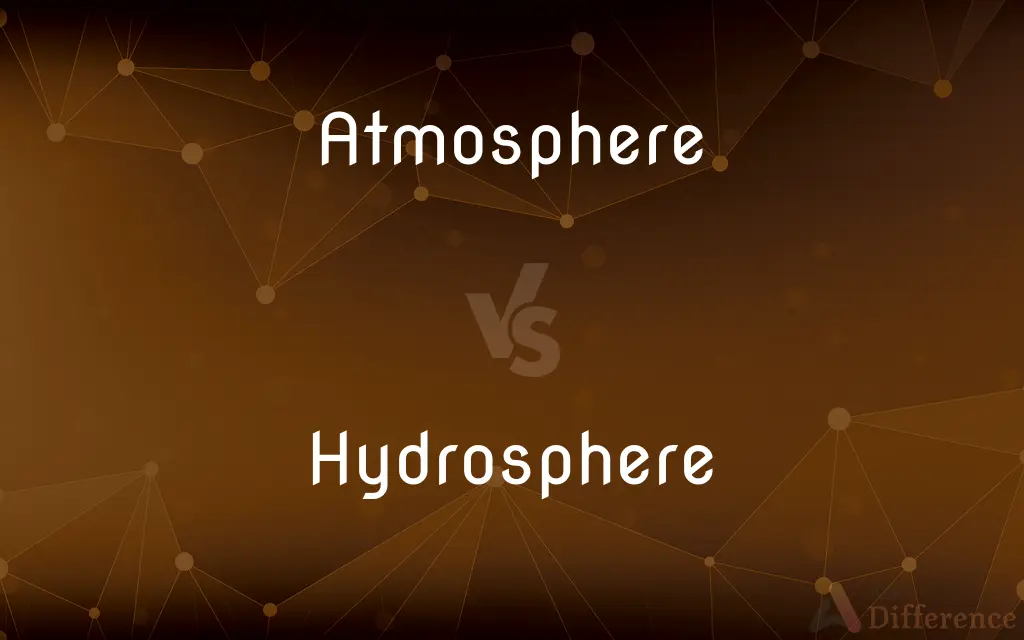Atmosphere vs. Hydrosphere — What's the Difference?
By Tayyaba Rehman & Maham Liaqat — Updated on April 2, 2024
The atmosphere is the layer of gases surrounding Earth, crucial for weather and climate, whereas the hydrosphere encompasses all water bodies, vital for Earth's water cycle and life.

Difference Between Atmosphere and Hydrosphere
Table of Contents
ADVERTISEMENT
Key Differences
The atmosphere, a complex layer of gases surrounding Earth, plays a pivotal role in protecting life by absorbing ultraviolet solar radiation, warming the surface through heat retention (greenhouse effect), and reducing temperature extremes between day and night. In contrast, the hydrosphere includes all of Earth's water bodies, such as oceans, seas, rivers, lakes, and water vapor in the atmosphere, integral to the water cycle and supporting diverse ecosystems.
While the atmosphere consists mainly of nitrogen (78%) and oxygen (21%), with traces of other gases like argon, carbon dioxide, and water vapor, the hydrosphere is predominantly water in liquid form, with significant portions in solid form as ice (polar ice caps, glaciers) and a small percentage as water vapor. These two spheres interact closely, with the hydrosphere contributing to atmospheric humidity and the atmosphere influencing weather and climate patterns over water bodies.
The atmosphere is divided into several layers based on temperature gradients, including the troposphere (where weather occurs), stratosphere, mesosphere, thermosphere, and exosphere. The hydrosphere, however, is categorized by the type of water body and its location, including surface water (oceans, lakes, rivers) and groundwater.
Atmospheric processes, such as the circulation of air masses and the water cycle, directly impact weather and climate patterns, affecting human life and ecosystems. The hydrosphere plays a critical role in regulating Earth's climate through the storage and distribution of heat, with oceans absorbing a significant amount of solar radiation and distributing heat globally via currents.
Interactions between the atmosphere and hydrosphere are fundamental to Earth's environmental systems. For instance, the exchange of heat and moisture between the ocean and atmosphere drives weather events like hurricanes and monsoons, while the absorption of CO2 by oceans influences atmospheric composition and climate change.
ADVERTISEMENT
Comparison Chart
Composition
Layers of gases, mainly nitrogen and oxygen.
All of Earth's water bodies, including oceans, rivers, and glaciers.
Role
Protects life, influences weather and climate.
Supports life, integral to the water cycle and climate regulation.
Layers/Categories
Divided into the troposphere, stratosphere, mesosphere, thermosphere, and exosphere.
Categorized by water state and location: surface water and groundwater.
Impact
Affects weather patterns, temperature, and climate.
Regulates Earth's temperature, supports ecosystems.
Interaction
Exchanges heat and moisture with the hydrosphere, affecting weather and climate.
Influences atmospheric humidity and temperature, absorbs CO2.
Compare with Definitions
Atmosphere
Composed of nitrogen and oxygen.
Oxygen in the atmosphere is essential for human and animal life.
Hydrosphere
Encompasses all Earth's water.
The hydrosphere includes oceans, which cover 71% of the Earth's surface.
Atmosphere
Regulates Earth's temperature.
The atmosphere's greenhouse gases help maintain the planet's warmth.
Hydrosphere
Crucial for the water cycle.
The water cycle through the hydrosphere replenishes freshwater resources.
Atmosphere
Contains weather systems.
Weather patterns form within the lower layers of the atmosphere.
Hydrosphere
Supports diverse ecosystems.
The hydrosphere's varied environments host unique aquatic life forms.
Atmosphere
Vital for climate regulation.
Changes in the atmosphere can significantly impact global climates.
Hydrosphere
Regulates temperature.
Oceans in the hydrosphere absorb and redistribute solar energy.
Atmosphere
A protective layer of gases.
The Earth's atmosphere shields us from harmful solar radiation.
Hydrosphere
Interacts with the atmosphere.
Water vapor from the hydrosphere influences weather and climate patterns.
Atmosphere
An atmosphere (from the greek words ἀτμός (atmos), meaning 'vapour', and σφαῖρα (sphaira), meaning 'ball' or 'sphere') is a layer or a set of layers of gases surrounding a planet or other material body, that is held in place by the gravity of that body. An atmosphere is more likely to be retained if the gravity it is subject to is high and the temperature of the atmosphere is low.
Hydrosphere
The hydrosphere (from Greek ὕδωρ hydōr, "water" and σφαῖρα sphaira, "sphere") is the combined mass of water found on, under, and above the surface of a planet, minor planet, or natural satellite. Although Earth's hydrosphere has been around for about 4 billion years, it continues to change in shape.
Atmosphere
The gaseous mass or envelope surrounding a celestial body, especially the one surrounding the earth, and retained by the celestial body's gravitational field.
Hydrosphere
The waters of the earth's surface as distinguished from those of the lithosphere and the atmosphere.
Atmosphere
The air or climate in a specific place.
Hydrosphere
The water vapor in the earth's atmosphere.
Atmosphere
Abbr. atm Physics A unit of pressure equal to the air pressure at sea level. It equals the amount of pressure that will support a column of mercury 760 millimeters high at 0 degrees Celsius under standard gravity, or 14.7 pounds per square inch (1.01325 × 105 pascals).
Hydrosphere
All the liquid waters of the Earth, as distinguished from the land and the gases of the atmosphere.
Atmosphere
A dominant intellectual or emotional environment or attitude
An atmosphere of distrust among the electorate.
Hydrosphere
The aqueous vapor of the entire atmosphere.
Atmosphere
The dominant tone or mood of a work of art.
Hydrosphere
The aqueous envelope of the earth, including the ocean, all lakes, streams, and underground waters, and the aqueous vapor in the atmosphere.
Atmosphere
An aesthetic quality or effect, especially a distinctive and pleasing one, associated with a particular place
A restaurant with an Old World atmosphere.
Hydrosphere
The watery layer of the earth's surface; includes water vapor
Atmosphere
The gases surrounding the Earth or any astronomical body.
Atmosphere
The air in a particular place.
Atmosphere
The conditions (such as music, illumination etc.) that can influence the mood felt in an environment.
Atmosphere
The apparent mood felt in an environment.
Atmosphere
A unit of measurement for pressure equal to 101325 Pa (symbol: atm)
Atmosphere
Extras in a scene who have no spoken lines.
Atmosphere
The whole mass of aëriform fluid surrounding the earth; - applied also to the gaseous envelope of any celestial orb, or other body; as, the atmosphere of Mars.
An atmosphere of cold oxygen.
Atmosphere
A supposed medium around various bodies; as, electrical atmosphere, a medium formerly supposed to surround electrical bodies.
Atmosphere
The pressure or weight of the air at the sea level, on a unit of surface, or about 14.7 lbs. to the sq. inch.
Hydrogen was liquefied under a pressure of 650 atmospheres.
Atmosphere
Any surrounding or pervading influence or condition.
The chillest of social atmospheres.
Atmosphere
The portion of air in any locality, or affected by a special physical or sanitary condition; as, the atmosphere of the room; a moist or noxious atmosphere.
Atmosphere
A particular environment or surrounding influence;
There was an atmosphere of excitement
Atmosphere
A unit of pressure: the pressure that will support a column of mercury 760 mm high at sea level and 0 degrees centigrade
Atmosphere
The mass of air surrounding the Earth;
There was great heat as the comet entered the atmosphere
It was exposed to the air
Atmosphere
The weather or climate at some place;
The atmosphere was thick with fog
Atmosphere
The envelope of gases surrounding any celestial body
Atmosphere
A distinctive but intangible quality surrounding a person or thing;
An air of mystery
The house had a neglected air
An atmosphere of defeat pervaded the candidate's headquarters
The place had an aura of romance
Common Curiosities
What constitutes the hydrosphere?
The hydrosphere includes all of Earth's water in various forms, from oceans to ice caps and water vapor.
How do the atmosphere and hydrosphere interact?
They interact through the exchange of heat and moisture, significantly affecting weather, climate, and the water cycle.
What role does the hydrosphere play in Earth's climate?
It regulates Earth's temperature, supports the water cycle, and through its interactions with the atmosphere, affects weather patterns.
Why is the atmosphere important?
It protects Earth from harmful solar radiation, regulates temperature, and supports life by providing essential gases.
What defines the atmosphere?
The atmosphere is the layer of gases surrounding Earth, crucial for protecting life and influencing global climate.
How does the hydrosphere support life?
It provides habitats for a vast array of organisms and is essential for the water cycle, supporting terrestrial life forms.
How does water from the hydrosphere enter the atmosphere?
Through evaporation and transpiration, water vapor enters the atmosphere, contributing to weather and climate dynamics.
What impact does the hydrosphere have on weather?
The hydrosphere affects weather patterns through mechanisms like the distribution of heat by ocean currents and the formation of rain from water vapor.
Are the atmosphere and hydrosphere independent systems?
No, they are interdependent, with each system influencing and being influenced by the other.
What is the significance of atmospheric pressure?
Atmospheric pressure, determined by the weight of the air above, is crucial for weather patterns and life's existence at Earth's surface.
What are the main components of the atmosphere?
Nitrogen, oxygen, argon, carbon dioxide, and water vapor are the primary components.
What measures can help protect the atmosphere and hydrosphere?
Reducing greenhouse gas emissions, conserving water, preventing pollution, and protecting natural habitats can help preserve these vital Earth systems.
Can changes in the atmosphere affect the hydrosphere?
Yes, changes like global warming can alter ocean temperatures and currents, impacting global climate patterns.
How is climate change linked to the atmosphere and hydrosphere?
Climate change is driven by changes in atmospheric composition (like increased CO2 levels) and affects the hydrosphere by altering temperatures and water cycles.
How do human activities affect the atmosphere and hydrosphere?
Activities like burning fossil fuels and deforestation impact the atmosphere by increasing greenhouse gases, while pollution and overuse of water resources affect the hydrosphere's quality and availability.
Share Your Discovery

Previous Comparison
Currier vs. Courier
Next Comparison
Bear vs. FoxAuthor Spotlight
Written by
Tayyaba RehmanTayyaba Rehman is a distinguished writer, currently serving as a primary contributor to askdifference.com. As a researcher in semantics and etymology, Tayyaba's passion for the complexity of languages and their distinctions has found a perfect home on the platform. Tayyaba delves into the intricacies of language, distinguishing between commonly confused words and phrases, thereby providing clarity for readers worldwide.
Co-written by
Maham Liaqat












































